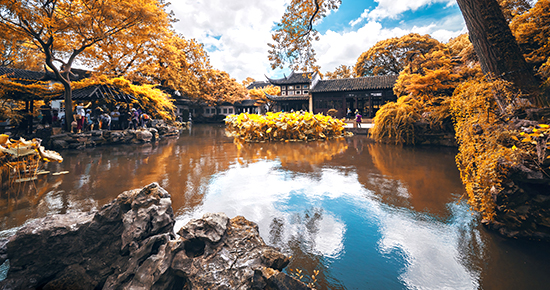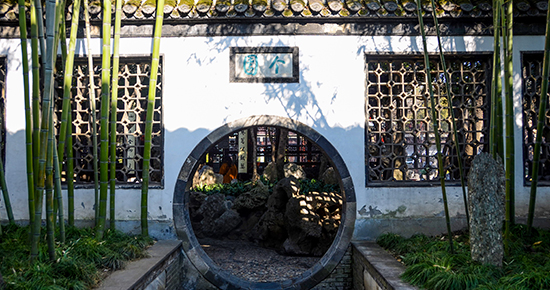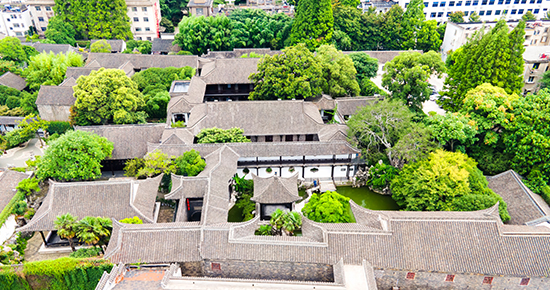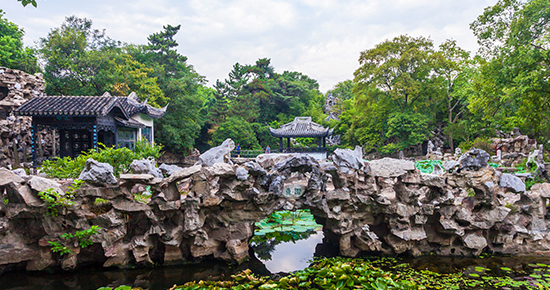Gardens
Gardens in China, whether classic or modern, always boast charming scenery, unique architectures, and great fun, thus becoming popular tourist attractions in the eyes of travelers home and abroad. Ingenious gardeners always perfectly blend the natural scenery with artificial gardens, leaving visitors feel walking in the painting of grotesque rocks, rare flora and fauna, and rippling lakes. Another feature of gardens lies in the combination of Chinese poetry, painting and gardens. Generally speaking, royal gardens in the northern part of China have strong colours and look magnificent, while the private ones in the south are usually small but elegant and tranquil.
Lingering Garden (Garden to linger in)
One of the Four Best Known Classical Gardens of China, Lingering Garden of Suzhou is celebrated for ingenious layout of architectures and a great deal of rare rocks. It was inscribed in the first batch of cultural relics protected under the nation in 1961 and in the World Heritage List in 1997.
Originally a garden of a senior official mansion of Ming Dynasty (1368-1644), Lingering garden was rebuilt by Liu Shu in Qing Dynasty (1644-1911), who had a distinguished expert design the garden and firstly named the garden as Liu Garden after his family name. The garden was later purchased by Sheng Xuren (father of Sheng Xuanhuai, an eminent businessman and statesman, as well as the founder of present Tianjin University and Shanghai Jiaotong University). He expanded and renovated the garden and named the garden as Lingering Garden, also called Liu Garden in Chinese, reserving the previous pronunciation.

Humble Administrator's Garden
one of the Four Most Famous Gardens of China (the other three are Summer Palace of Beijing, Imperial Summer Villa of Chengde and Lingering Garden of Suzhou), the Humble Administrator’s Garden is the largest as well as the most famed in Suzhou and contains almost all the features of classical Suzhou gardens. Has been inscribed as a World Heritage Site by UNESCO in 1997, Humble Administrator’s Garden is celebrated by its exquisite layout of pools, rockeries, islets, bamboo grove, pines, pavilions and corridors. It is the representative and example of classical gardens in the south regions of the Yangtze River, and hailed as the "mother of Chinese gardens".

Constructed on a former site of a residence of Tang poet which then rebuilt as a temple in Yuan Dynasty (1271-1368), the Humble Administrator's Garden was originally built in 1509 during Ming Dynasty (1368-1644). It was completed for 16 years by Wang Xiancheng, who retired from his official career and had famous painter Wen Zhengming design the garden with concepts of poetry and traditional Chinese painting. Compared himself a humble and took gardening instead of the government affairs as his business, the founder named his garden as Humble Administrator's Garden. However, after the owner’s death, his son lost out the garden in a gambling to Xu family. And for over 500 years, the garden has undergone numerous changes and divisions as private garden, or government offices, or dwellings. It is till 1950s that the garden was reunited eventually by the government.
Covering about 52000 square meters, most of the architectures in Humble Administrator’s Garden were built in 1850 when it served as the palace garden of the Taiping Heavenly Kingdom (1851-1864). And in late Qing Dynasty (1644-1911), the garden has developed to present three characteristic parts, the Eastern Garden, Western Garden and Central Garden.
The Garden of Master-of-the-Net
The Master of the Nets Garden was originally built in 1174 during Southern Song Dynasty (1127-1279) by a senior official; and it named as Yu Yin (渔隐, Seclusion of fisherman) because the founder was inspired by the simple and solitary life as a retired fisherman. Afterwards, the garden has undergone numerous ownerships, but fortunately most of the owners are refined scholars who added not only delicate constructions and plants but also the literal inscriptions and cultural atmosphere to the garden. It is in 1785 when the garden was taken over by Song Zongyuan, a retired official of Qing Dynasty (1644-1911), who redesigned the garden with retained spirits and renamed the garden the Master of the Nets Garden, as an expression of his wish for the simple life as a fisherman. In 1868, the garden was transferred to Li Hongyi, an imperial official and master calligrapher, who had left about half of the steles in the garden. It is later in 1940 that the He Chang possessed the garden and stipulated in his will to donate the garden to the government which was eventually fulfilled by his daughter in 1958.

Lion Grove
As one of the Four Best Known Classical Gardens in Suzhou, the Lion Grove is a typical southern garden of Yuan Dynasty (1271-1368). Originally a back garden of a Buddhist temple built in 1342, the latest renovation was made from 1917 to 1926. As a representative of Suzhou classical garden, Lion Grove is equipped with pavilions, terraces, halls, galleries and corridors; furthermore, it is a garden characterized by rocks and rockeries, and eulogized as the Kingdom of Rockeries. It has been inscribed into World Heritage List. Have undergone ups and downs, and segregated as an independent garden or residence from the temple for several times, the landscape gardening of Lion Grove is intentionally mixed with that of Buddhist theories, the family ancestral hall and western elements, all of which make it a temple garden with both rational Chan and recreational function of gardens.

Covering 1.1 hectare, standing on a rectangle land, Lion Grove of Suzhou is a grand maze with scattered rockeries, encircled corridors, distinctive pavilions and twisted paths. Pool centered in the central part, rocks and rockeries are mainly found in southeast, and waters in northwest. With a compact layout, rocks, pavilions, plants and bridges are built one after another, painting a picture with rich contents. On the walls of corridors are inscribed calligraphies of the Four Greatest Calligraphers of Song Dynasty (960-1279), Su Dungpo, Mi Fu, Huang Tingchien, and Cai Xiang, as well as the painting of Wen Tianxiang, a national hero and patriotic poet of Northern Song Dynasty (1127-1279).
Ge Garden
In Yangzhou, many splendid private gardens, which were built by some salt dealers in Qing Dynasty (1644 - 1911), are well-retained. Among the all, Ge Garden is the oldest and best-preserved one with great artistic value.
Ge Garden of Yangzhou, or Geyuan (Chinese: 个园), located in the north of the ancient city, was built by a salt dealer Huang Zhiyun in 1818 during Qing Dynasty. Bamboo grove of a wide variety is the vivid characteristic of Ge Garden, and it is interesting that the name of "Ge Garden (个园)" came from bamboo leaves: every three connecting bamboo leaves look like the Chinese character "个" and double "个" is just the character ”竹(bamboo)”.

He Garden
He Garden or He Yuan in Chinese (何园), is located in Xuningmen Street in Yangzhou City, Jiangsu Province. It is a major cultural relic site under national protection, built in later Qing Dynasty with an area of more than 14,000 square meters. The construction built in the garden takes up about half of the area, which is also the feature of late Qing Dynasty gardens. Built by He Zhidao, an official of Qing Dynasty, He Garden widely employed new materials to combine Chinese royal gardens and private gardens with western elements.

Li Garden
Li Garden (Chinese:蠡园) lies on the western bank of Li Lake in Qingqi Village, 2.5 kilometers to the southwest of Wuxi City, Jiangsu Province. Li Garden was built in 1927, covering an area of 5.2 hectares including 2.2 hectares water area. The water surface of Li Lake is about 10 square kilometers, which is 1.7 times the size of Hangzhou West Lake. And a 300-meter-long Baojie Bridge, the longest bridge in Wuxi, divides the lake into two parts.
